Abstract
Anterior nares cultures from 664 hospital personnel identified 165 (24.8%) as carriers of Staphylococcus aureus. Persistent carriers (17.8%) were identified and randomly assigned to one of four treatment groups: rifampin (600 mg once a day for 5 days), bacitracin ointment (topically applied three times a day for 10 days), combined rifampin and bacitracin, and control (no treatment). Bacitracin ointment was ineffective in eliminating S. aureus from the anterior nares and had a postreatment carrier rate equal to the control rate. Rifampin therapy caused a highly significant reduction (79%) in carriage; however, combined therapy was not as effective as treatment with rifampin alone. Of 132 strains of staphylococci isolated before and after treatment, all were susceptible to less than 0.016 micrograms of rifampin per ml. This study demonstrates that rifampin may be an effective antistaphylococcal antibiotic and could be used to control the carrier state in high-risk situations.
Full text
PDF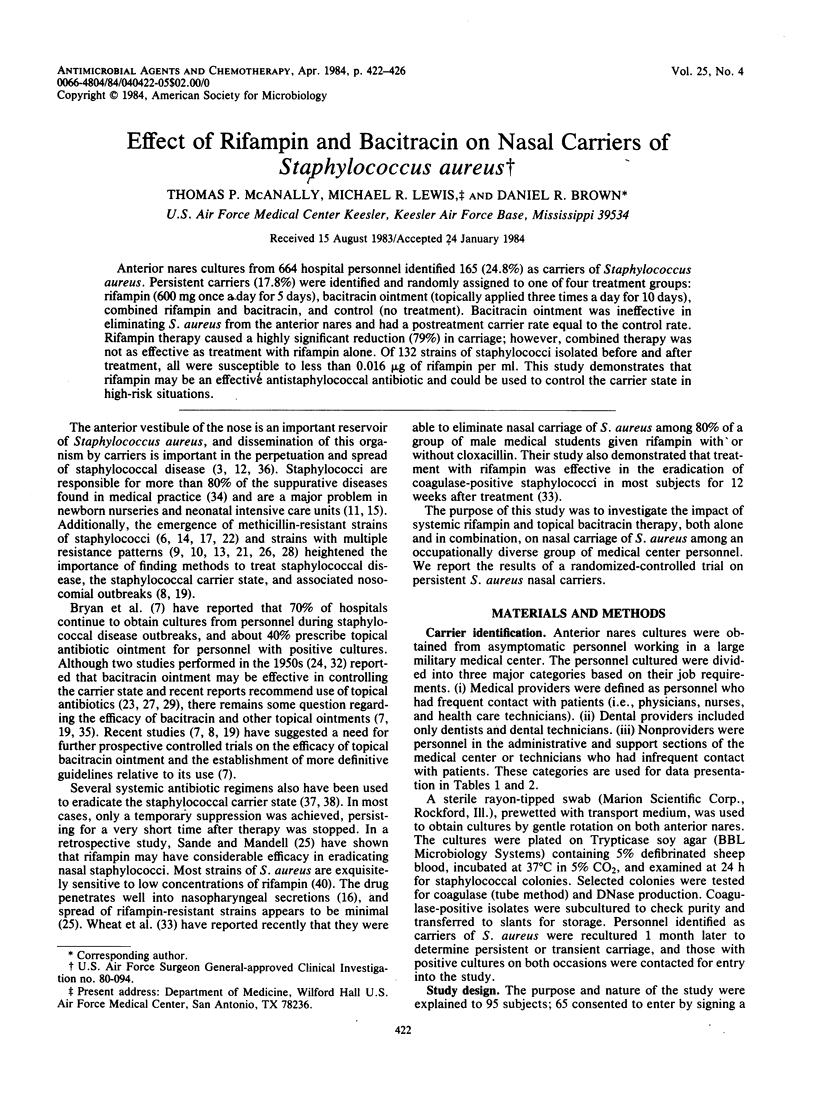
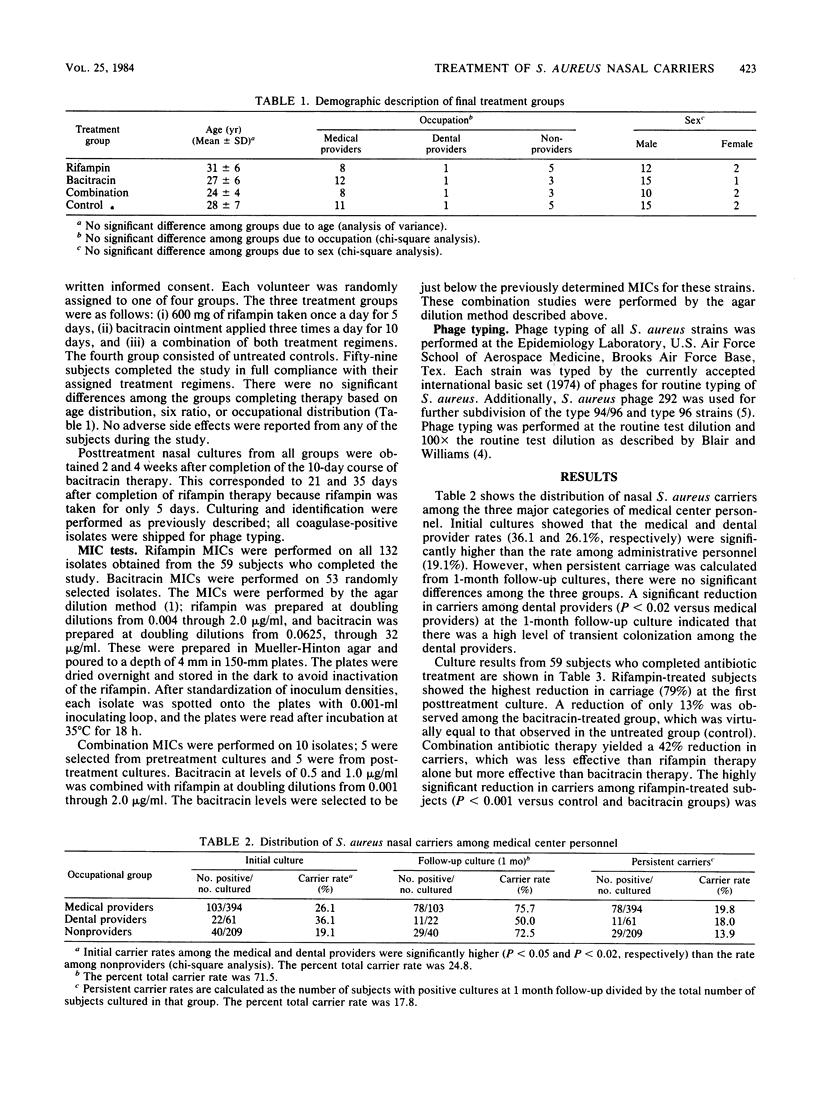
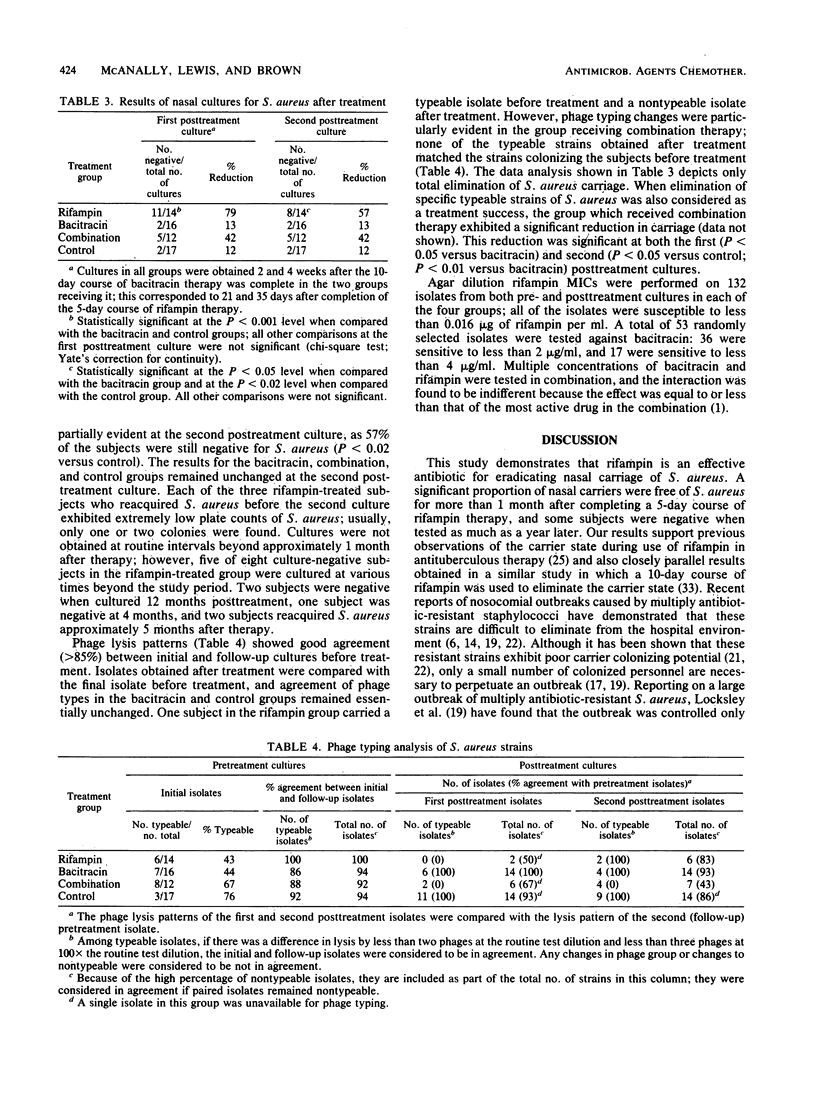
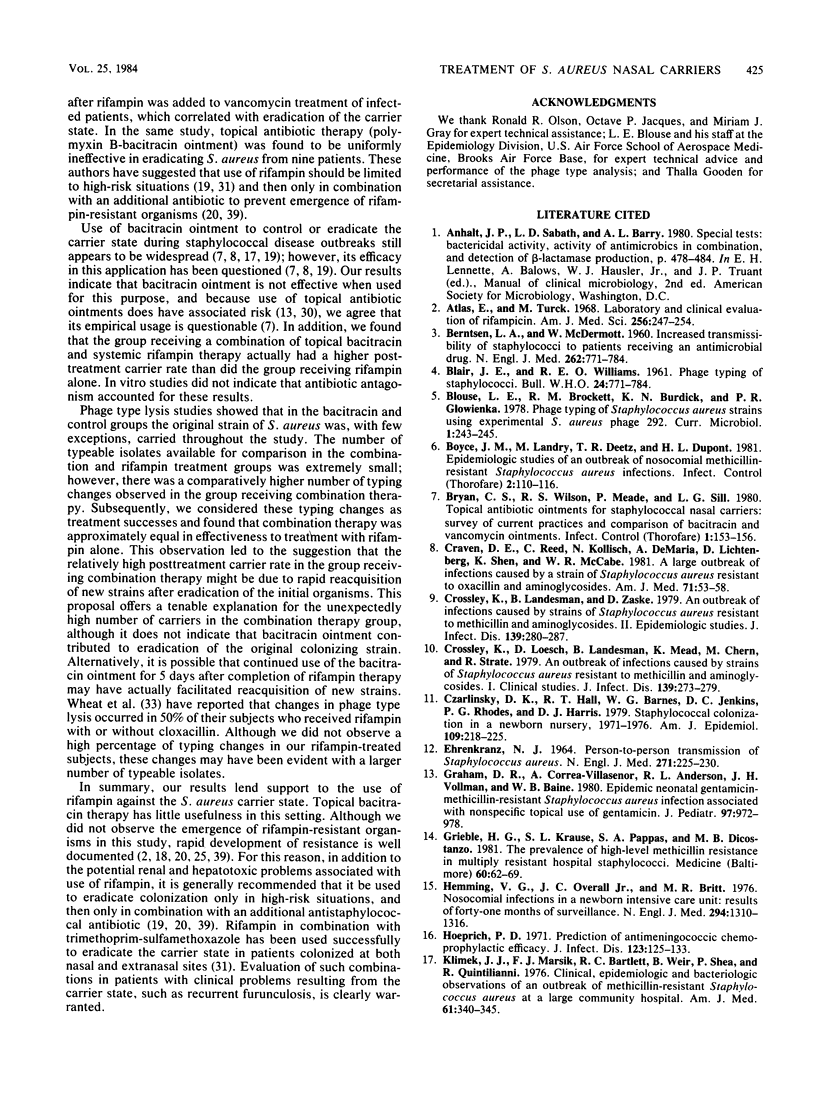
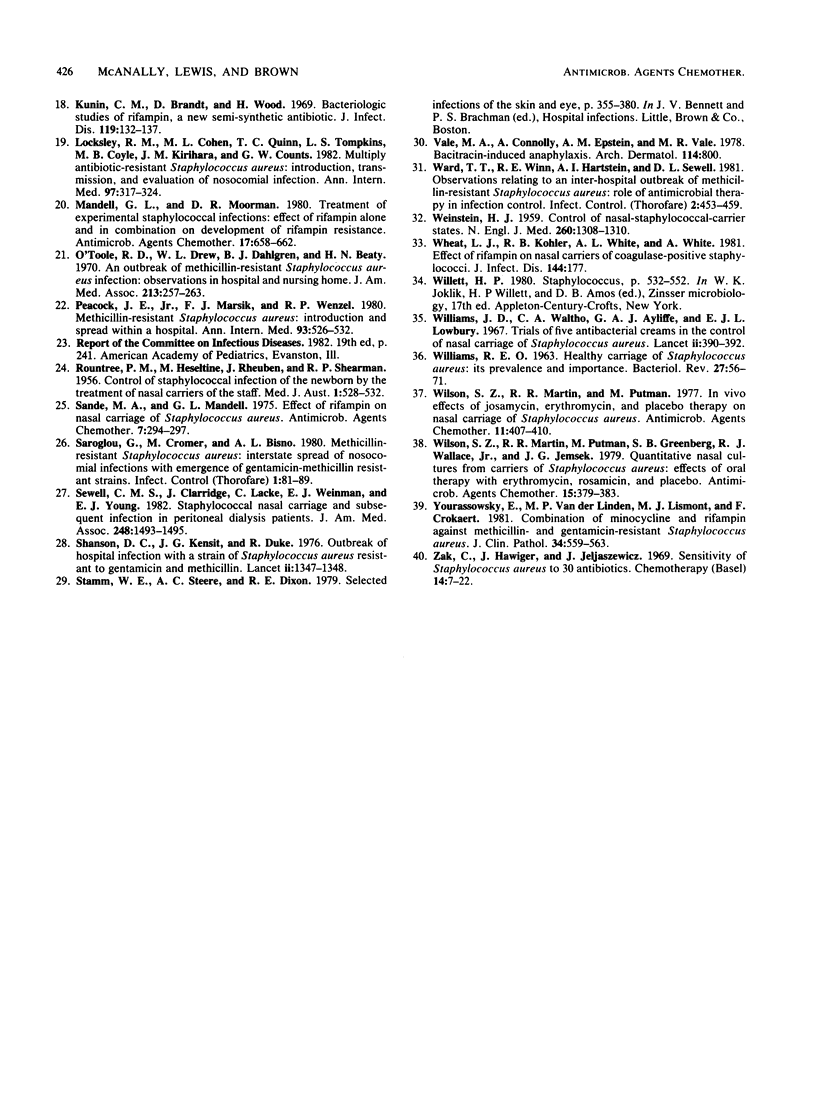
Selected References
These references are in PubMed. This may not be the complete list of references from this article.
- Boyce J. M., Landry M., Deetz T. R., DuPont H. L. Epidemiologic studies of an outbreak of nosocomial methicillin-resistant Staphylococcus aureus infections. Infect Control. 1981 Mar-Apr;2(2):110–116. doi: 10.1017/s0195941700053881. [DOI] [PubMed] [Google Scholar]
- Bryan C. S., Wilson R. S., Meade P., Sill L. G. Topical antibiotic ointments for staphylococcal nasal carriers: survey of current practices and comparison of bacitracin and vancomycin ointments. Infect Control. 1980 May-Jun;1(3):153–156. doi: 10.1017/s0195941700052875. [DOI] [PubMed] [Google Scholar]
- Craven D. E., Reed C., Kollisch N., DeMaria A., Lichtenberg D., Shen K., McCabe W. R. A large outbreak of infections caused by a strain of Staphylococcus aureus resistant of oxacillin and aminoglycosides. Am J Med. 1981 Jul;71(1):53–58. doi: 10.1016/0002-9343(81)90258-8. [DOI] [PubMed] [Google Scholar]
- Crossley K., Landesman B., Zaske D. An outbreak of infections caused by strains of Staphylococcus aureus resistant to methicillin and aminoglycosides. II. Epidemiologic studies. J Infect Dis. 1979 Mar;139(3):280–287. doi: 10.1093/infdis/139.3.280. [DOI] [PubMed] [Google Scholar]
- Crossley K., Loesch D., Landesman B., Mead K., Chern M., Strate R. An outbreak of infections caused by strains of Staphylococcus aureus resistant to methicillin and aminoglycosides. I. Clinical studies. J Infect Dis. 1979 Mar;139(3):273–279. doi: 10.1093/infdis/139.3.273. [DOI] [PubMed] [Google Scholar]
- Czarlinsky D. K., Hall R. T., Barnes W. G., Jenkins D. C., Rhodes P. G., Harris D. J. Staphylococcal colonization in a newborn nursery, 1971--1976. Am J Epidemiol. 1979 Feb;109(2):218–225. doi: 10.1093/oxfordjournals.aje.a112676. [DOI] [PubMed] [Google Scholar]
- EHRENKRANZ N. J. PERSON-TO-PERSON TRANSMISSION OF STAPHYLOCOCCUS AUREUS. QUANTITATIVE CHARACTERIZATION OF NASAL CARRIERS SPREADING INFECTION. N Engl J Med. 1964 Jul 30;271:225–230. doi: 10.1056/NEJM196407302710503. [DOI] [PubMed] [Google Scholar]
- Graham D. R., Correa-Villasenor A., Anderson R. L., Vollman J. H., Baine W. B. Epidemic neonatal gentamicin-methicillin--resistant Staphylococcus aureus infection associated with nonspecific topical use of gentamicin. J Pediatr. 1980 Dec;97(6):972–978. doi: 10.1016/s0022-3476(80)80439-2. [DOI] [PubMed] [Google Scholar]
- Grieble H. G., Krause S. L., Pappas S. A., DiCostanzo M. B. The prevalence of high-level methicillin resistance in multiply resistant hospital staphylococci. Medicine (Baltimore) 1981 Jan;60(1):62–69. doi: 10.1097/00005792-198101000-00006. [DOI] [PubMed] [Google Scholar]
- Hemming V. G., Overall J. C., Jr, Britt M. R. Nosocomial infections in a newborn intensive-care unit. Results of forty-one months of surveillance. N Engl J Med. 1976 Jun 10;294(24):1310–1316. doi: 10.1056/NEJM197606102942403. [DOI] [PubMed] [Google Scholar]
- Hoeprich P. D. Prediction of antimeningococcic chemoprophylactic efficacy. J Infect Dis. 1971 Feb;123(2):125–133. doi: 10.1093/infdis/123.2.125. [DOI] [PubMed] [Google Scholar]
- Klimek J. J., Marsik F. J., Bartlett R. C., Weir B., Shea P., Quintiliani R. Clinical, epidemiologic and bacteriologic observations of an outbreak of methicillin-resistant Staphylococcus aureus at a large community hospital. Am J Med. 1976 Sep;61(3):340–345. doi: 10.1016/0002-9343(76)90370-3. [DOI] [PubMed] [Google Scholar]
- Kunin C. M., Brandt D., Wood H. Bacteriologic studies of rifampin, a new semisynthetic antibiotic. J Infect Dis. 1969 Feb;119(2):132–137. doi: 10.1093/infdis/119.2.132. [DOI] [PubMed] [Google Scholar]
- Locksley R. M., Cohen M. L., Quinn T. C., Tompkins L. S., Coyle M. B., Kirihara J. M., Counts G. W. Multiply antibiotic-resistant Staphylococcus aureus: introduction, transmission, and evolution of nosocomial infection. Ann Intern Med. 1982 Sep;97(3):317–324. doi: 10.7326/0003-4819-97-3-317. [DOI] [PubMed] [Google Scholar]
- Mandell G. L., Moorman D. R. Treatment of experimental staphylococcal infections: effect of rifampin alone and in combination on development of rifampin resistance. Antimicrob Agents Chemother. 1980 Apr;17(4):658–662. doi: 10.1128/aac.17.4.658. [DOI] [PMC free article] [PubMed] [Google Scholar]
- O'Toole R. D., Drew W. L., Dahlgren B. J., Beaty H. N. An outbreak of methicillin-resistant Staphylococcus aureus infection. Observations in hospital and nursing home. JAMA. 1970 Jul 13;213(2):257–263. [PubMed] [Google Scholar]
- Peacock J. E., Jr, Marsik F. J., Wenzel R. P. Methicillin-resistant Staphylococcus aureus: introduction and spread within a hospital. Ann Intern Med. 1980 Oct;93(4):526–532. doi: 10.7326/0003-4819-93-4-526. [DOI] [PubMed] [Google Scholar]
- ROUNTREE P. H., HESELTINE M., RHEUBEN J., SHEARMAN R. P. Control of staphylococcal infection of the newborn by the treatment of nasal carriers in the staff. Med J Aust. 1956 Mar 31;43(13):528–532. [PubMed] [Google Scholar]
- Sande M. A., Mandell G. L. Effect of rifampin on nasal carriage of Staphylococcus aureus. Antimicrob Agents Chemother. 1975 Mar;7(3):294–297. doi: 10.1128/aac.7.3.294. [DOI] [PMC free article] [PubMed] [Google Scholar]
- Saroglou G., Cromer M., Bisno A. L. Methicillin-resistant Staphylococcus aureus: interstate spread of nosocomial infections with emergence of gentamicin-methicillin resistant strains. Infect Control. 1980 Mar-Apr;1(2):81–89. doi: 10.1017/s0195941700052590. [DOI] [PubMed] [Google Scholar]
- Sewell C. M., Clarridge J., Lacke C., Weinman E. J., Young E. J. Staphylococcal nasal carriage and subsequent infection in peritoneal dialysis patients. JAMA. 1982 Sep 24;248(12):1493–1495. [PubMed] [Google Scholar]
- Shanson D. C., Kensit J. C., Duke R. Outbreak of hospital infection with a strain of Staphylococcus aureus resistant to gentamicin and methicillin. Lancet. 1976 Dec 18;2(7999):1347–1348. doi: 10.1016/s0140-6736(76)91986-3. [DOI] [PubMed] [Google Scholar]
- Vale M. A., Connolly A., Epstein A. M., Vale M. R. Bacitracin-induced anaphylaxis. Arch Dermatol. 1978 May;114(5):800–800. [PubMed] [Google Scholar]
- WEINSTEIN H. J. The relation between the nasal-staphylococcal-carrier state and the incidence of postoperative complications. N Engl J Med. 1959 Jun 25;260(26):1303–1308. doi: 10.1056/NEJM195906252602601. [DOI] [PubMed] [Google Scholar]
- WILLIAMS R. E. Healthy carriage of Staphylococcus aureus: its prevalence and importance. Bacteriol Rev. 1963 Mar;27:56–71. doi: 10.1128/br.27.1.56-71.1963. [DOI] [PMC free article] [PubMed] [Google Scholar]
- Ward T. T., Winn R. E., Hartstein A. I., Sewell D. L. Observations relating to an inter-hospital outbreak of methicillin-resistant Staphylococcus aureus: role of antimicrobial therapy in infection control. Infect Control. 1981 Nov-Dec;2(6):453–459. doi: 10.1017/s0195941700055715. [DOI] [PubMed] [Google Scholar]
- Wheat L. J., Kohler R. B., White A. L., White A. Effect of rifampin on nasal carriers of coagulase-positive staphylococci. J Infect Dis. 1981 Aug;144(2):177–177. doi: 10.1093/infdis/144.2.177. [DOI] [PubMed] [Google Scholar]
- Williams J. D., Waltho C. A., Ayliffe G. A., Lowbury E. J. Trials of five antibacterial creams in the control of nasal carriage of Staphylococcus aureus. Lancet. 1967 Aug 19;2(7512):390–392. doi: 10.1016/s0140-6736(67)92010-7. [DOI] [PubMed] [Google Scholar]
- Wilson S. Z., Martin R. R., Putman M., Greenberg S. B., Wallace R. J., Jr, Jemsek J. G. Quantitative nasal cultures from carriers of Staphylococcus aureus: effects of oral therapy with erythromycin, rosamicin, and placebo. Antimicrob Agents Chemother. 1979 Mar;15(3):379–383. doi: 10.1128/aac.15.3.379. [DOI] [PMC free article] [PubMed] [Google Scholar]
- Wilson S. Z., Martin R. R., Putman M. In vivo effects of josamycin, erythromycin, and placebo therapy on nasal carriage of Staphylococcus aureus. Antimicrob Agents Chemother. 1977 Mar;11(3):407–410. doi: 10.1128/aac.11.3.407. [DOI] [PMC free article] [PubMed] [Google Scholar]
- Yourassowsky E., van der Linden M. P., Lismont M. J., Crokaert F. Combination of minocycline and rifampicin against methicillin- and gentamicin-resistant Staphylococcus aureus. J Clin Pathol. 1981 May;34(5):559–563. doi: 10.1136/jcp.34.5.559. [DOI] [PMC free article] [PubMed] [Google Scholar]
- Zak C., Hawiger J., Jeljaszewicz J. Sensitivity of Staphylococcus aureus to 30 antibiotics. Chemotherapy. 1969;14(1):7–21. doi: 10.1159/000220607. [DOI] [PubMed] [Google Scholar]


